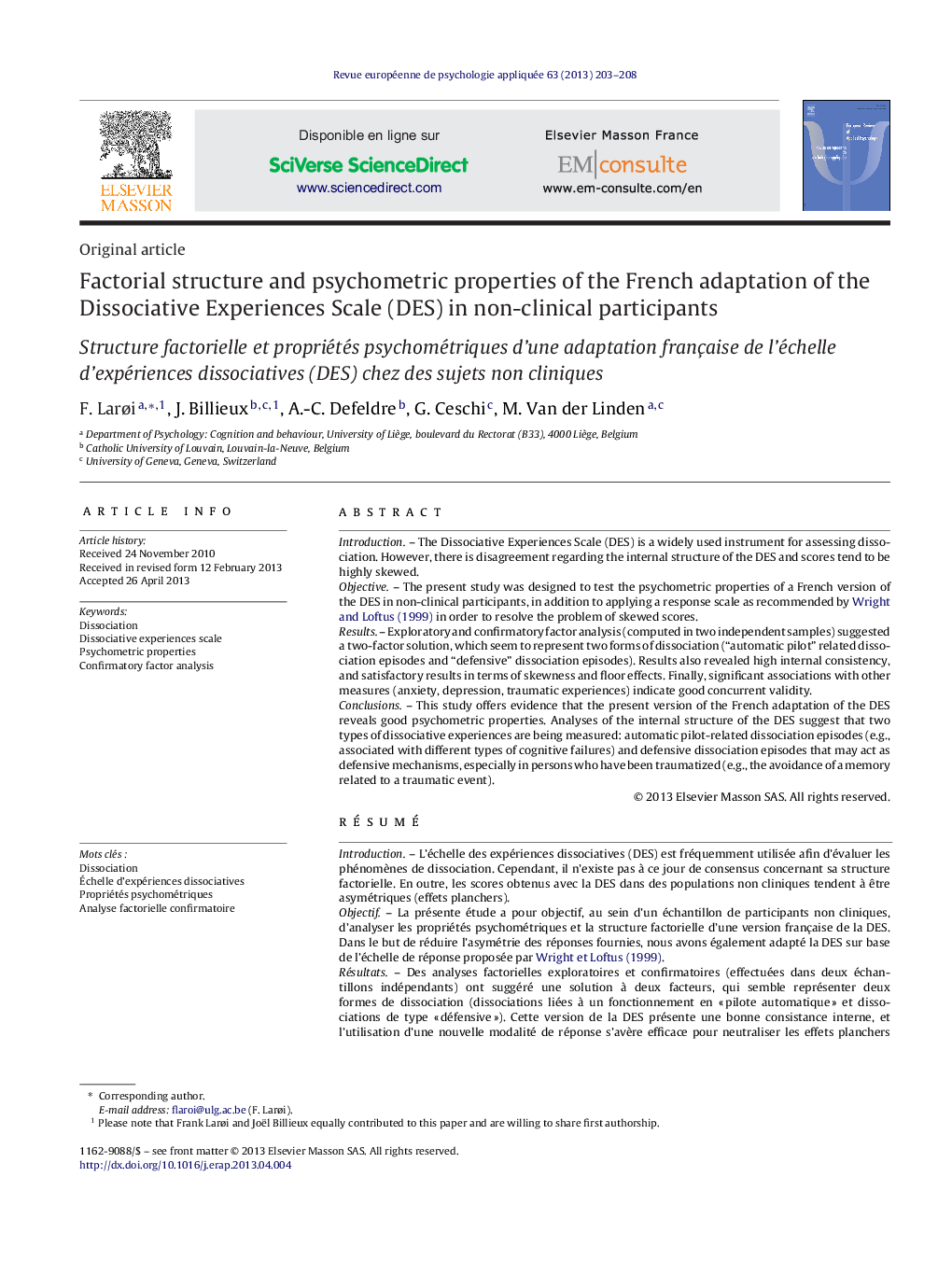| کد مقاله | کد نشریه | سال انتشار | مقاله انگلیسی | نسخه تمام متن |
|---|---|---|---|---|
| 895508 | 914659 | 2013 | 6 صفحه PDF | دانلود رایگان |

IntroductionThe Dissociative Experiences Scale (DES) is a widely used instrument for assessing dissociation. However, there is disagreement regarding the internal structure of the DES and scores tend to be highly skewed.ObjectiveThe present study was designed to test the psychometric properties of a French version of the DES in non-clinical participants, in addition to applying a response scale as recommended by Wright and Loftus (1999) in order to resolve the problem of skewed scores.ResultsExploratory and confirmatory factor analysis (computed in two independent samples) suggested a two-factor solution, which seem to represent two forms of dissociation (“automatic pilot” related dissociation episodes and “defensive” dissociation episodes). Results also revealed high internal consistency, and satisfactory results in terms of skewness and floor effects. Finally, significant associations with other measures (anxiety, depression, traumatic experiences) indicate good concurrent validity.ConclusionsThis study offers evidence that the present version of the French adaptation of the DES reveals good psychometric properties. Analyses of the internal structure of the DES suggest that two types of dissociative experiences are being measured: automatic pilot-related dissociation episodes (e.g., associated with different types of cognitive failures) and defensive dissociation episodes that may act as defensive mechanisms, especially in persons who have been traumatized (e.g., the avoidance of a memory related to a traumatic event).
RésuméIntroductionL’échelle des expériences dissociatives (DES) est fréquemment utilisée afin d’évaluer les phénomènes de dissociation. Cependant, il n’existe pas à ce jour de consensus concernant sa structure factorielle. En outre, les scores obtenus avec la DES dans des populations non cliniques tendent à être asymétriques (effets planchers).ObjectifLa présente étude a pour objectif, au sein d’un échantillon de participants non cliniques, d’analyser les propriétés psychométriques et la structure factorielle d’une version française de la DES. Dans le but de réduire l’asymétrie des réponses fournies, nous avons également adapté la DES sur base de l’échelle de réponse proposée par Wright et Loftus (1999).RésultatsDes analyses factorielles exploratoires et confirmatoires (effectuées dans deux échantillons indépendants) ont suggéré une solution à deux facteurs, qui semble représenter deux formes de dissociation (dissociations liées à un fonctionnement en « pilote automatique » et dissociations de type « défensive »). Cette version de la DES présente une bonne consistance interne, et l’utilisation d’une nouvelle modalité de réponse s’avère efficace pour neutraliser les effets planchers (asymétrie des scores) fréquemment obtenus avec cette échelle chez des participants non cliniques. Pour terminer, des associations significatives avec d’autres mesures (anxiété, dépression, expériences traumatisantes) indiquent une bonne validité concurrente.ConclusionsLes résultats de cette étude indiquent que cette version française de la DES dispose de bonnes propriétés psychométriques. Cette échelle mesure deux types d’expériences dissociatives : les expériences dissociatives de type pilote automatique (e.g., associées à un mode de traitement de l’information automatique plutôt que contrôlé) et les expériences dissociatives défensives (e.g., l’évitement de souvenirs reliés à un événement traumatique).
Journal: Revue Européenne de Psychologie Appliquée/European Review of Applied Psychology - Volume 63, Issue 4, July 2013, Pages 203–208